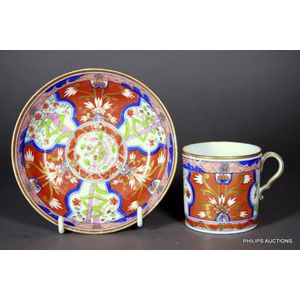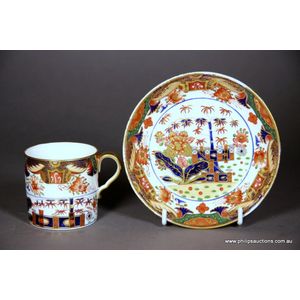Spode Imari Tea Cup & Saucer, 1807
You must be a subscriber, and be logged in to view price and dealer details.
Subscribe Now to view actual auction price for this item
When you subscribe, you have the option of setting the currency in which to display prices to $Au, $US, $NZ or Stg.
- Kakiemon Porcelain - Kakiemon porcelain was made from the 16th to the 19th century in the Arita area of Japan, and is generally agreed to include some of the finest porcelain made in Japan. It is decorated with polychrome enamels over glaze, the most popular colours being underglaze blue and enamels of green, blue, turquoise yellow and persimmon red.
The body of a Kakiemon object is pure white porcelain while the enamel overglaze motifs incorporate Japanese and Chinese designs, but leave much of the white surface unpainted. The name derives from the family of potters who are associated with this style of pottery.
Early Kakiemon porcelain was unmarked, and marks on later objects were variable and unreliable.
Kakiemon porcelain was first imported into Europe by the Dutch at the end of the 17th century, and became extremely popular, resulting in Kakiemon-style imitations being produced by European potteries including Bow, Chelsea and Worcester in England, Mennery, Samson and St. Cloud in France, Delft in Holland and Meissen in Germany.
It's rare for an original Kakiemon object to come onto the market, and almost all sold nowadays is of European origin, and described as Kakiemon pattern or Kakiemon style. - Circa - A Latin term meaning 'about', often used in the antique trade to give an approximate date for the piece, usually considered to be five years on either side of the circa year. Thus, circa 1900 means the piece was made about 1900, probably between 1895 and 1905. The expression is sometimes abbreviated to c.1900.
This item has been included into following indexes:
- Copeland Spode (England), item types - tea pots and tea sets 90
- Copeland Spode (England), patterns
Visually similar items

A New Hall tea cup and saucer, circa 1805, pattern 274, the bute cup and bowl decorated with blue, rose, apple green and orange colours with gilt enrichments upon a white ground, a blue floral border punctuated with orange flowers to the rims, height 6 cm,

A coffee can and saucer in 'Dollar' pattern, probably Spode, circa 1800, unmarked, the straight-sided can with a loop handle with kink and a matching saucer, vibrantly decorated in the Imari palette with cross hatched and cloud borders enclosing shaped and

A Royal Crown Derby Imari cup and saucer, 1914, pattern 5852, in the typical iron red, cobalt and gilded Imari palette depicting flowers and lattice within an asymmetric blue and gilt patterned border; backstamps, pattern number and date cypher underside t

A fine Dr Wall Worcester tea cup and saucer, circa 1770, in 'Kakiemon' pattern and typically decorated in an iron red, emerald palette to fine gilded rococo reserves upon a scale blue ground; with a blue fret mark underside, saucer diameter 13 cm
